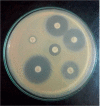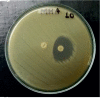Prevalence of Methicillin-Resistant Staphylococcus aureus in Shrines
- PMID: 32190054
- PMCID: PMC7068152
- DOI: 10.1155/2020/7981648
Prevalence of Methicillin-Resistant Staphylococcus aureus in Shrines
Abstract
Methicillin-resistant Staphylococcus aureus (MRSA) infection in human beings and animals is concerning; it stands out as one of the leading agents causing nosocomial and community infections. Also, marginally increasing drug resistance in MRSA has limited therapeutic options. This study focuses on estimating the prevalence of MRSA in shrines, a place where human and animal interaction is frequent, sharing antibiotic-resistant bacteria, antibiotic-resistant genes, and diseases. A total of 120 environmental swabs were collected from targeted areas during the study period, March 2018 to May 2018. Staphylococcus aureus was identified by growth on mannitol salt agar (MSA), and MRSA by growth on mannitol salt agar containing 4 μg Oxacillin, Gram staining, and conventional biochemical test. Isolates of S. aureus were characterized by antibiotic susceptibility testing using the disc diffusion method. MRSA and methicillin-sensitive S. aureus (MSSA) proportion were 19% and 81%, respectively; a high rate of MRSA was observed in isolates from Thapathali (28.6%). MSSA isolates showed a high rate of resistance to erythromycin (64.7%). MRSA isolates were resistant to gentamicin (50%), cotrimoxazole (25%), erythromycin (50%), and ciprofloxacin (25%). The isolates were susceptible to linezolid (100%), clindamycin (100%), ciprofloxacin (75%), erythromycin (50%), tetracycline (100%), and cotrimoxazole (75%). Intermediate resistance was also found in gentamicin (50%). Of the 11 MSSA isolates that were erythromycin resistant and clindamycin sensitive, 6 (54.5%) showed the inducible clindamycin resistance (ICR) pattern and 2 MRSA isolates that were erythromycin resistant and clindamycin sensitive showed ICR pattern. Fifteen MSSA isolates were β-lactamase positive, whereas only two MRSA isolates showed β-lactamase production. There exists a minimal research work on infectious diseases that are shared between primates and animals. This study suggests the pervasiveness of MRSA/MSSA in the shrines, which may be a primary place for pathogen exchange between humans and primates.
Copyright © 2020 Charu Arjyal et al.
Conflict of interest statement
The authors declare that they have no conflicts of interest.
Figures







Similar articles
-
Nosocomial Infections and Drug Susceptibility Patterns in Methicillin Sensitive and Methicillin Resistant Staphylococcus aureus.J Clin Diagn Res. 2013 Oct;7(10):2178-80. doi: 10.7860/JCDR/2013/6750.3463. Epub 2013 Sep 16. J Clin Diagn Res. 2013. PMID: 24298469 Free PMC article.
-
Prevalence and Antimicrobial Susceptibility Pattern of Methicillin-resistant Staphylococcus Aureus [MRSA] Isolates at a Tertiary Care Hospital in Mangalore, South India.J Lab Physicians. 2010 Jul;2(2):82-4. doi: 10.4103/0974-2727.72155. J Lab Physicians. 2010. PMID: 21346902 Free PMC article.
-
Australian Group on Antimicrobial Resistance (AGAR) Australian Staphylococcus aureus Sepsis Outcome Programme (ASSOP) Annual Report 2020.Commun Dis Intell (2018). 2022 Apr 26;46. doi: 10.33321/cdi.2022.46.18. Commun Dis Intell (2018). 2022. PMID: 35469556
-
Australian Group on Antimicrobial Resistance (AGAR) Australian Staphylococcus aureus Surveillance Outcome Program (ASSOP).Commun Dis Intell (2018). 2022 Dec 15;46. doi: 10.33321/cdi.2022.46.76. Commun Dis Intell (2018). 2022. PMID: 36529133
-
Prevalence and genotypic relatedness of methicillin resistant Staphylococcus aureus in a tertiary care hospital.J Postgrad Med. 2014 Oct-Dec;60(4):386-9. doi: 10.4103/0022-3859.143964. J Postgrad Med. 2014. PMID: 25370547
Cited by
-
Evaluation of Stress-Tolerant Serratia and Enterobacter as PGPR for Nutrient Solubilization and Dose-Dependent Bioformulation to Enhance Tomato Seedlings.Plants (Basel). 2025 Jul 13;14(14):2154. doi: 10.3390/plants14142154. Plants (Basel). 2025. PMID: 40733392 Free PMC article.
-
Infection of neonates with Staphylococcus aureus and methicillin-resistant Staphylococcus aureus at Dormaa Presbyterian Hospital, Ghana.Microbiol Spectr. 2025 Jun 3;13(6):e0174924. doi: 10.1128/spectrum.01749-24. Epub 2025 May 15. Microbiol Spectr. 2025. PMID: 40372039 Free PMC article.
-
Occurrence of Antibiotic-Resistant Staphylococcus spp. in Orange Orchards in Thailand.Int J Environ Res Public Health. 2021 Dec 27;19(1):246. doi: 10.3390/ijerph19010246. Int J Environ Res Public Health. 2021. PMID: 35010506 Free PMC article.
-
Synergistic Antibacterial Activity with Conventional Antibiotics and Mechanism of Action of Shikonin against Methicillin-Resistant Staphylococcus aureus.Int J Mol Sci. 2022 Jul 7;23(14):7551. doi: 10.3390/ijms23147551. Int J Mol Sci. 2022. PMID: 35886892 Free PMC article.
-
Multi-drug resistant bacteria isolates from lymphatic filariasis patients in the Ahanta West District, Ghana.BMC Microbiol. 2022 Oct 11;22(1):245. doi: 10.1186/s12866-022-02624-9. BMC Microbiol. 2022. PMID: 36221074 Free PMC article.
References
-
- Fleming A. On the antibacterial action of cultures of a penicillium, with special reference to their use in the isolation of B. influenza. British Journal of Experimental Pathology. 1929;10(3):226–236. - PubMed
-
- Jevons M. P. “Celbenin”-resistant staphylococci. BMJ. 1961;1(5219):124–125. doi: 10.1136/bmj.1.5219.124-a. - DOI
LinkOut - more resources
Full Text Sources
Other Literature Sources
Molecular Biology Databases

